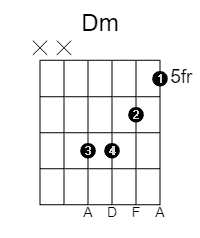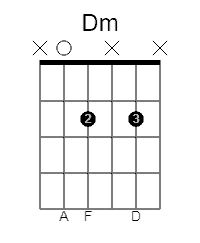The Dm chord is comprised of the notes D, F, and A
In terms of intervals, it has a root, a minor 3rd, and a perfect 5th
It can also be named or notated as Dm, D-, Dmin, or D minor.
If you are just starting out on guitar or need a refresher on this chord, stick around.
In this article, I will show you the easiest ways of playing this chord on guitar, and give you some tips and tricks to make it work out as it should.
After leaving this page you will have learned the must-know shapes of this triad, and also a lot about how it works in context with other chords.
Hey, I will even give you a fretboard diagram so you can work out your own voicing!
Let’s get to it.
Basic shape

The secret to playing the Dm chord is learning how much force you have to apply to the strings for them to ring properly without getting tired or making your fingers hurt.
This is one of the easiest open chords to play on the guitar, however, take your time and try to get a good sound out of it.
It is a great starting point to build finger stamina and dexterity.
Here are some tips for getting it sounding right:
- Fret with the tip of your fingers
- Press the strings near the fret wire
- Learn how much pressure is the minimum required
- Have the thumb from your fretting hand at the middle or lower back part of the neck
- Arch your fingers
- If it hurts, take a break!
2 easy ways of playing the Dm chord


Although the open version of this chord is one of the easiest you will find, having alternatives is always good.
Both these voicings are just broken versions of the standard bar form of the chord, which I will show you a bit further below, but they work great as they are since they have all the important notes in them.
Try them out to get your fingers prepared for the harder challenges ahead.
Open voicings of the Dm chord
Here are some alternative ways of playing this chord near the nut of your guitar, close to where you will find most other open chords.
If you want alternative sounds for this classic chord, I encourage you to try them out!
These also use some open strings, so these shapes are not movable across the fretboard.


Moveable voicings of the Dm chord
As their name implies, these moveable voicings can be shifted along the neck getting you different chords of the same quality.
The root note of the chord, for these voicings, as you can see, is defined by the lowest note played.


Also, for the second shape, the one with the barre, if you struggle with it sounding clear, you could try also pressing it down with your second finger, which is otherwise free.
Dm chord fretboard map

You can use this fretboard map to come up with your own chord voicings.
Just remember that you will need at least one of each chord note for it to be outlined properly.
Songs to practice the Dm chord
Pink Floyd – Another Brick in the Wall
Amy Winehouse – Back to Black
Robbie Williams – Feel
Scales and modes that have the Dm chord, and their chords
The following scales and modes have this chord inside them.
This means that it will “fit” among their other chords, however, given the context, the feeling that it gives will be shifted.
In some of these scales it will sound like a resting point, and in others more like a tension agent.
D minor scale chords, Dm is i
| i | iiº | III | iv | v | VI | VII |
| Dm | Edim | F | Gm | Am | Bb | C |
C major scale chords, Dm is ii
| I | ii | iii | IV | V | vi | viiº |
| C | Dm | Em | F | G | Am | Bdim |
Bb major scale chords, Dm is iii
| I | ii | iii | IV | V | vi | viiº |
| Bb | Cm | Dm | Eb | F | Gm | Adim |
A minor scale chords, Dm is iv
| i | iiº | III | iv | v | VI | VII |
| Am | Bdim | C | Dm | Em | F | G |
G minor scale chords, Dm is v
| i | iiº | III | iv | v | VI | VII |
| Gm | Adim | Bb | Cm | Dm | Eb | F |
F major scale chords, Dm is vi
| I | ii | iii | IV | V | vi | viiº |
| F | Gm | Am | Bb | C | Dm | Edim |
E Phrygian scale chords, Dm is vii
| i | II | III | iv | vº | VI | vii |
| Em | F | G | Am | Bdim | C | Dm |
Inversions of the Dm chord
The inversions of a chord are just a different order for the notes that comprise them.
They are notated with a / before the indication of the note that should be used as the bass.
Triad chords have, naturally 2 inversions.
Dm inversions are:
- Dm/F
- Dm/A
Extensions of the Dm chord
Extensions are extra notes you can add to the chord to spice it up.
To know exactly which notes you can use you will have to check the key and scale you are playing in.
Some of the most common extensions of the Dm chord are:
- Dm6
- Dm7
- Dm9
- Dm11

Hello there, my name is Ramiro and I’ve been playing guitar for almost 20 years. I’m obsessed with everything gear-related and I thought it might be worth sharing it. From guitars, pedals, amps, and synths to studio gear and production tips, I hope you find what I post here useful, and I’ll try my best to keep it entertaining also.





